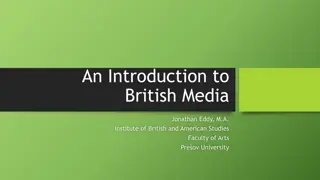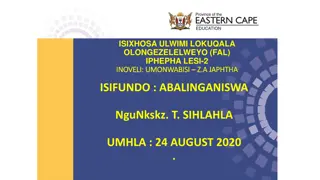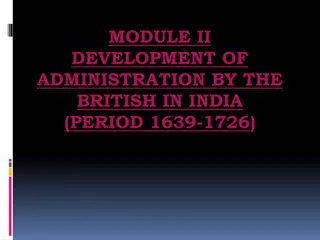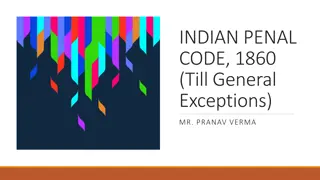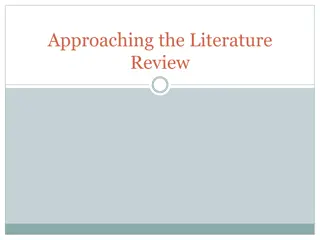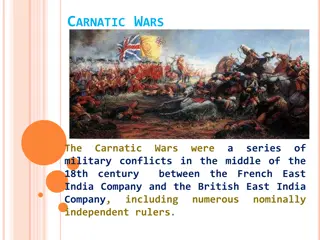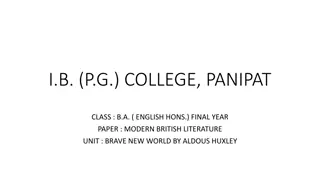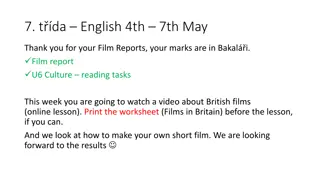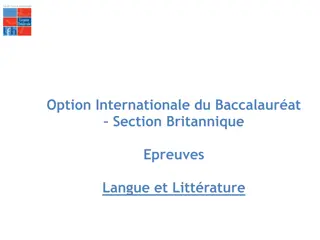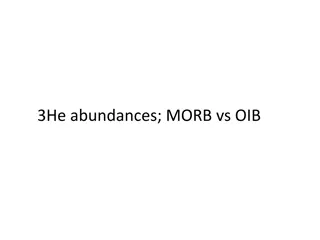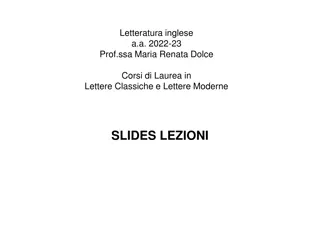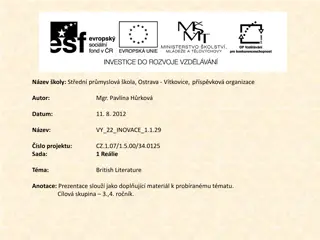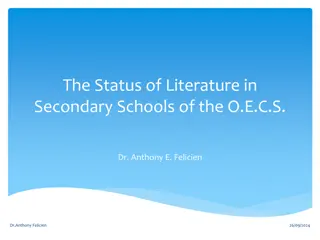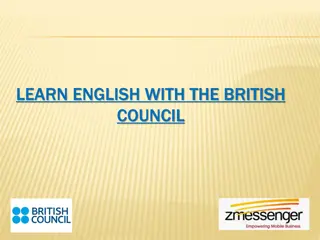OIB BRITISH OPTION LANGUAGE AND LITERATURE
The OIB British Option Language and Literature examination guidelines for 2022 outline the texts students need to prepare, format of written and oral examinations, key issues in Gothic and Post-War Writing, and more. Students must choose Shakespeare plays, prose, drama, and poetry texts, and engage with Synoptic Topics like Gothic Writing or Post-War Writing. The oral examination includes discussing key issues within the chosen topic. Prepare effectively by understanding the requirements and expectations set for the examinations.
Download Presentation

Please find below an Image/Link to download the presentation.
The content on the website is provided AS IS for your information and personal use only. It may not be sold, licensed, or shared on other websites without obtaining consent from the author.If you encounter any issues during the download, it is possible that the publisher has removed the file from their server.
You are allowed to download the files provided on this website for personal or commercial use, subject to the condition that they are used lawfully. All files are the property of their respective owners.
The content on the website is provided AS IS for your information and personal use only. It may not be sold, licensed, or shared on other websites without obtaining consent from the author.
E N D
Presentation Transcript
OIB BRITISH OPTION LANGUAGE AND LITERATURE First examination 2022
FIRST, A REMINDER The text grid for 2022 remains unchanged The number of texts to prepare remains unchanged
EXAMINATIONS 2022
WHAT DO STUDENTS PREPARE? Written examination One Shakespeare play - chosen from two set Two works chosen from a selection of prose, drama and poetry texts. Chosen texts must be from different genres; three texts will be set in each genre Oral examination One of the two Synoptic Topics: Gothic Writing, or Post-War Writing of the 1950s and 1960s: Two main texts chosen from the list for the topic Six set core poems for the topic
WRITTEN EXAMINATION (4 HOURS) Part One: The Shakespeare play: candidates answer one question on the play prepared for the examination. There will be a choice of two questions on each of the two plays. Each question consists of two parts: (i) analysis of an extract, and (ii) broader discussion of some of the issues in the extract in the play as a whole Part Two: The two other works: candidates answer two questions, one on each of the two works prepared. Candidates answer three questions in all. Each question is worth 20 marks.
ORAL EXAMINATION (15 MINUTES): THE SYNOPTIC TOPIC GOTHIC WRITING/POST-WAR WRITING A number of key issues within each topic will be defined by the Cambridge Inspector. Candidates will be asked to begin the oral by speaking on one of these key issues for 5 minutes. This will be followed by further discussion of the key issue and broader discussion of the synoptic topic. Candidates will have 20 minutes preparation time for the oral examination. At the beginning of the preparation time, each candidate will be informed of the key issue they will be expected to address in the examination.
KEY ISSUES: GOTHIC WRITING EXAMPLES The role of the supernatural in Gothic writing Gender politics in Gothic writing The importance of settings in Gothic writing
KEY ISSUES IN POST-WAR WRITING - EXAMPLES The representation and expression of gender in post-war writing The role of heroes/ villains/ anti-heroes in post-war writing
WHY ARE WE DOING THIS? To make the oral exam more sustainable (by nearly doubling oral examining capacity) To allow for fuller moderation of the oral exam To make the oral exam more clearly focused, and more straightforward to conduct and assess To align HG and L&L oral examinations in duration and coefficient. Both subjects now have a coefficient of 5 for the oral, but the current L&L oral is currently twice as long as the HG oral: 30 minutes as opposed to 15 To improve the balance of written and oral texts in proportion to the coefficients: the written exam currently carries double the coefficient of the oral but examines half as many texts To maintain the equivalence with A level by introducing a written Shakespeare question based on OCR and Cambridge Assessment International A level approaches Above all, to retain the strengths and the richness of the OIB while simplifying it (in the context of the overall bac reform) and making it sustainable
IN OTHER NEWS New UCAS Qualification Information Profile (reference for Admissions Tutors) recognises that the OIB is equivalent to 4 A-levels in terms of size


